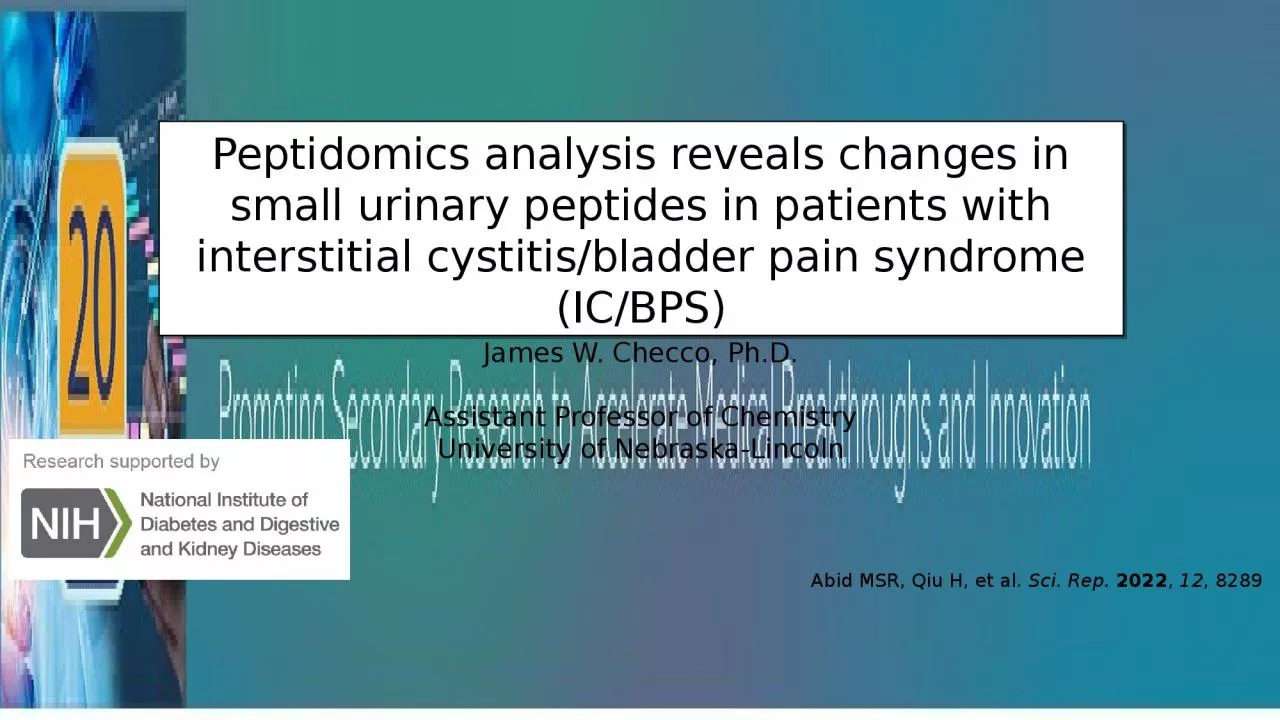

James W Checco PhD Assistant Professor of Chemistry University of NebraskaLincoln Peptidomics analysis reveals changes in small urinary peptides in patients with interstitial cystitisbladder pain syndrome ICBPS ID: 1040715
Download Presentation The PPT/PDF document "Chemical approaches to understand peptid..." is the property of its rightful owner. Permission is granted to download and print the materials on this web site for personal, non-commercial use only, and to display it on your personal computer provided you do not modify the materials and that you retain all copyright notices contained in the materials. By downloading content from our website, you accept the terms of this agreement.
1. Chemical approaches to understand peptide signaling in diseaseJames W. Checco, Ph.D.Assistant Professor of ChemistryUniversity of Nebraska-LincolnPeptidomics analysis reveals changes in small urinary peptides in patients with interstitial cystitis/bladder pain syndrome (IC/BPS)Abid MSR, Qiu H, et al. Sci. Rep. 2022, 12, 8289
2. OverviewObtained human urine samples from female patients who participated in NIDDK’s Multidisciplinary Approach to the Study of Chronic Pelvic Pain (MAPP) research network – Administrative Review mechanismInterstitial cystitis/bladder pain syndrome (IC/BPS)Chronic syndrome characterized by pain in the lower pelvisEtiology not well understood. Some symptoms include:Bladder painIncreased urinary urgencyFrequent urinationGlomerations on bladder wallHunner’s ulcers on bladder wallMany symptoms overlap with other bladder diseasesHighly invasive (cystoscopy, bladder biopsy, etc.)There is a significant need for non-invasive and reliable biomarkers to aid in the diagnosis of IC/BPS Urinary systemfrom niddk.nih.gov
3. Research workHypothesis: Small peptides (products of natural proteolysis) in urine may be useful as IC/BPS biomarkers.Goals:Non-targeted peptidomics analysis of urinary peptides in IC/BPS patient urine versus healthy control urineTargeted relative quantitation of APF peptide in IC/BPS urine versus healthy control urineObservations:“APF peptide” appears to be potential biomarker for IC/BPS, but other small peptides have not been exploredChronic inflammation and increased protease activity are associated with IC/BPS
4. 100 μL patient urineDesalt via solid-phase extractionUrine peptide enrichment via “Proteospin”LC-MS and LC-MS/MS analysisTwo-stage peptide enrichmentRed points indicate significant peptides with >1.5-fold changeProcessed 87 patient urine samples (43 IC/BPS, 44 control) from NIDDK CRLC-MS/MS (DDA) followed by analysis in PEAKS Studio identifies >1000 peptides from >150 proteins (1% FDR)71 specific peptides in higher abundance in IC/BPS patient urine relative to control urineHigher controlHigher IC/BPSScientific accomplishments
5. Scientific accomplishments (continued)**p<0.01, unpaired t-testAPF peptide detected in both patient and control urine samples, but absent from many samplesWhen present, APF peptide is in higher abundance in IC/BPS urine relative to control urineSuggests that APF peptide alone (in this form) may not be definitive biomarker for IC/BPS. APF peptide abundance
6. Scientific accomplishments (continued)Hypothesis: Small peptides (products of natural proteolysis) in urine may be useful as IC/BPS biomarkers.Goals and accomplishments:Non-targeted peptidomics analysis of urinary peptides in IC/BPS patient urine versus healthy control urineGeneral increase in small peptide abundance in IC/BPSSpecific peptides may act as putative biomarkersTargeted relative quantitation of APF peptide in IC/BPS urine versus healthy control urineAPF peptide is not consistently found in IC/BPS patient urine, potentially limiting utility as biomarker.
7. Scientific career journeyAbid MSR, Qiu H, et al. Sci. Rep. 2022, 12, 8289Began as Assistant Professor in August 2019Received Ferring Innovation Grant to study peptides in IC/BPS in October, 2019 (lab’s first funding!)Published results in 2022 (lab’s first research publication!)Access to CR samples integral for getting my lab’s research off the ground in its early stages
8. Helpful hintsAsk for minimal amount of sample required for study – if impact to collection is low, it may be possible to be approved by administrative review.Reach out and ask questions to CR personnel!
9. AcknowledgementsChecco GroupMd Shadman Ridwan AbidMadeline AllenAshley CliftonAlisha DodaJannat al FoisalSomayeh MousaviSheryl SharmaChase StebbingBaba YussifNoelle WaltenburgIC/BPS CollaboratorsMax Qiu (UNL Biotechnology, CIBC)Bridget Tripp (UNL CIBC)Robert Powers (UNL Chemistry)Heidi Roth (UNL Chemistry)Aline de Lima Leite (UNL CIBC)Jiri Adamec (UNL Biochemistry)FundingNIH/NIGMS MIRA (R35 GM142784)Nebraska EPSCoR FIRST Award (OIA-1557417)Ferring Innovation Grant (Ferring Pharmaceuticals)Nebraska Center for Integrated Biomolecular Communication (P20 GM113126)